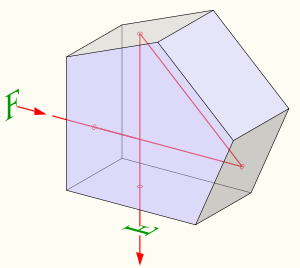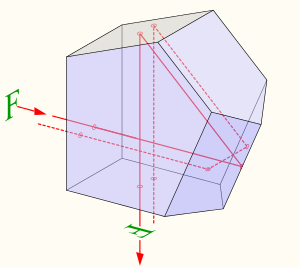

A pentaprism is a five-sided reflecting prism used to deviate a beam of light by a constant 90°, even if the entry beam is not at 90° to the prism. The beam reflects inside the prism twice,[1] allowing the transmission of an image through a right angle without inverting it (that is, without changing the image's handedness) as an ordinary right-angle prism or mirror would.
The reflections inside the prism are not caused by total internal reflection, since the beams are incident at an angle less than the critical angle (the minimum angle for total internal reflection). Instead, the two faces are coated to provide mirror surfaces. The two opposite transmitting faces are often coated with an antireflection coating to reduce spurious reflections. The fifth face of the prism is not used optically but truncates what would otherwise be an awkward angle joining the two mirrored faces.
YouTube Encyclopedic
-
1/3Views:57 9162 90210 432
-
Pentaprism vs Pentamirror (HD Version)
-
Pentaprism
-
Nikon D500 Magic PENTAPRISM 🤔 PART 4: D500 UNIQUE PRISM !!
Transcription
Hey – this is James from the Photography Incyder Info blog. So a few months ago I wrote an article about the advantages and disadvantages of a pentaprism versus a pentamirror and several people contacted me via the ‘Contact Us’ page on the blog and just asked for a little bit more information so I thought I’d re-write the article and include answers to their questions but I thought it might help you a little by showing you a pentaprism and a pentamirror and actually show you the physical objects so in front of you here I’ve got two old film cameras. One has a pentaprism the other has a pentamirror and I’m actually going to take them apart and show you the bits so I’m going to put this one to one side for a moment. I should of course say to you that if you take a camera apart you’re almost certainly going to break it so I would not recommend you do it. You don’t want to buy a new just to satisfy your own curiosity about what’s inside. But let me do it for you so you can see. Now in here as I say this is an old film camera. You’ve got the lens mount here the light passes through the lens on to the reflex mirror inside here. So there you actually have the reflex mirror – that’s what makes a single lens reflex – it gives it its name you have this reflex mirror, this mirror that can move up and down and normally in its normal position the light from the lens reflects on to the mirror or reflects off the mirror up here in to the roof of the camera where there is a focusing screen a ground glass screen on to which the image is focused and when you press the shutter release the mirror swings out of the way and allows the light to fall on to if it’s a digital camera the light sensor or a film camera the film. And obviously there is the shutter in the way which actually controls how much time the light is allowed to fall on the sensor for. But the mirror moves out of the way and allows that process to happen. But normally you want to be able to look through the lens you want to be able to see the image and so the viewfinder here is mounted in the same direction as the lens so that you face forward it feels natural and you need some way by which the image from the lens hits your eye in a natural way so that it’s the right way up-and-down and left-to-right and that is the job of the pentaprism or the pentamirror it flips the image up the correct way around so that you can actually focus and see properly so it helps with panning if everything’s going in the right direction so as I said I’m going to take this apart now. Please do not do this to your own cameras you will break them. And if I just lift that top off there and expose the electronics inside you can see the various controls there electronic chips computer chips which control the operation of the camera and I’ve already taken this apart so I can flip that out of the way that circuit board out of the way and you’re now looking at the pentaprism. It doesn’t look very much really it’s a piece of black – well at the moment you can’t really tell what it is but it’s black but if I flip that up and lift it I can lift that glass out of the camera and notice for a moment that where the lens piece is that the piece of glass that was facing it is clear it’s transparent and also notice that the underside again is transparent but all of the other edges are painted black they are actually mirrored they are painted with silver compound and then painted black to protect it. I’ll put that down for one moment just to show you the focusing screen. So there’s the screen and it’s on that focussing screen there that the image would normally be focussed and as I said when the mirror flips out of the way the image the light from the lens rather than being sent up here to the focusing screen would be sent back on to the sensor or the film to record the image. So if I take that out of the way and there we have that is the pentaprism. It’s a piece of fairly chunky glass. It is quite heavy. It’s quite substantial. It’s optical glass. It’s extremely clear and probably very expensive to make. So the reason why you tend to get them on higher end cameras is they are probably a fairly expensive piece of kit to make. So I’ll put that down there while we now get the pentamirror. So same thing I’ve pre-dismantled this camera. You’ve got the same electronics or similar electronics at the top here and if I reveal the pentamirror and pull it out it’s the same exactly the same orientation. You’ve got the viewfinder here. The light does its thing to flip the image up the right way until it exits or it enters the camera through the lens and exits through the eyepiece. Now if I just put them side by side. Other than the fact that this one actually has the lens piece built in the eye piece built in to this. They are actually very very similar. They are similar in shape, they are similar in size. This one happens to have, because of its design the focussing screen is built in to the piece but the first difference that I can see the weight. They are incredibly different in terms of weight. That one is incredibly light. That one is very very heavy. And if I just grab some scales I should actually be able to weigh them for you. I don’t know whether you can see that – let me just turn that on. I can’t really see that very well I haven’t focussed very well but anyway I’ll put the pentaprism on first. The pentaprism weighs 1 and a half ounces. Okay, pentaprism one and a half ounces. Pentamirror is just half an ounce. So the pentaprism is three times the weight. Advantages and disadvantages – well I discuss those in the article so carry on reading but you can see that the physical makeup of that there is no way at all that dust can get inside the pentaprism because it’s make of a solid chunk of glass. Whereas with this I guess that it’s possible. The design is such that I’m sure it’s unlikely but if I just slide this clip – and different pentaprism different pentamirrors are going to be designed in different ways – but if I just slide that pin out it’s actually possible to take the focussing screen off and now you can see that there are all these mirrors inside and if I just grab a screwdriver it’s possible for me to actually put the screwdriver inside the pentamirror there. And so one of the things about pentamirrors that you often hear is that dust can enter the pentamirror and cause you problems. But for a discussion on that and to see if that’s a genuine concern or not then just carry on reading the article on the Photography Incyder Blog. I hope that’s been helpful to you. Carry on reading and pop back there are some other interesting articles here and I’m writing more all the time. If you contact me via the ‘Contact Us’ page of the blog and tell me the kind of things you’re interested in I can produce articles on those. For the moment if you’d like to scroll down the page and read the rest of the article. This is James from the Photography Incyder Info blog.
In cameras

A variant of this prism is the roof pentaprism which is commonly used in the viewfinder of single-lens reflex cameras.[1][2] The camera lens renders an image that is both vertically and laterally reversed, and the reflex mirror re-inverts it leaving an image laterally reversed. In this case, the image needs to be reflected left-to-right as the prism transmits the image formed on the camera's focusing screen. This lateral inversion is done by replacing one of the reflective faces of a normal pentaprism with a "roof" section, with two additional surfaces angled towards each other and meeting at 90°, which laterally reverses the image back to normal. Reflex cameras with waist-level finders (viewed from above), including many medium format cameras, display a laterally reversed image directly from the focusing screen which is viewed from above.
Compared to the pentamirror
The same optical paths can be realized with three mirrors, in an arrangement called the pentamirror. While substantially lighter, the light enters and exits the mirrors' glass several times, each time losing brightness and instead scattering. The pentaprism is typically much heavier, but only has one entrance and one exit, providing a notably superior optical performance. Additionally, pentamirrors can conceivably go out of alignment while a pentaprism's facets are perfectly aligned until it is destroyed. [3]
-
Zeiss Ikon Contax S with the world's first roof pentaprism on a single-lens reflex camera.
-
Nikon F with an interchangeable roof pentaprism — the first system camera with a roof pentaprism.
-
The standard DP-30 prism of a Nikon F5, removed.
-
Prism housing for Bronica ETR medium format cameras.
-
A cutaway view of a Praktica L2 showing the pentaprism.
In surveying

In surveying a double pentaprism (two pentaprisms stacked on top of each other) and a plumb-bob are used to stake out right angles, e.g. on a construction site.
See also

References
- ^ a b Norman Goldberg (1992). Camera Technology. Academic Press. ISBN 0-12-287570-2.
- ^ "Pentaprism: what is it and how does it work? - What Digital Camera". What Digital Camera. 14 April 2016. Retrieved 2018-05-12.
- ^ David D. Busch. Digital Photography All-in-One Desk Reference for Dummies, 2006, page 106.





